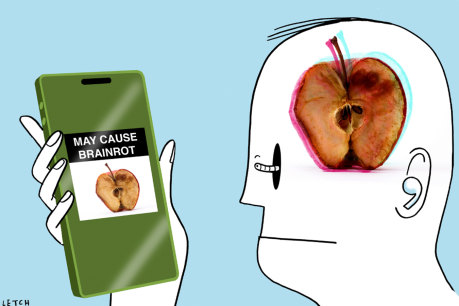Opinion
Frighten kids from social media? That would be a free ad to lure them
Malcolm Knox
Journalist, author and columnistChristiane F. was a 1982 German film with an anti-drug message. Based on a true story, it depicted a West Berlin teenager’s descent through the “gateway” of soft drugs into a harrowing fate of heroin addiction, prostitution and crime. Globally, Christiane F. was pushed by parents, schools and even churches to show what awaited kids who tried a joint or an LSD trip. Globally, the message backfired.

Illustration: Simon LetchCredit:
Adults thought Christiane F. would shock their kids into abstinence. Instead, with its David Bowie soundtrack and its pre-AIDS transgressive glamour, the film acted more like an advertisement. Girls began to dress like Christiane and to hang out at Berlin Zoo, where much of the story took place. Christiane Felscherinow, its author, became a minor celebrity who continued using drugs into midlife. Drug experts had warned that the film, if used as a kind of parental admonition, would have the contrary effect. They were right.
In the same decade, a different anti-drug campaign achieved comparative success. Governments backed moves to reduce cigarette smoking. Advertising was banned. Taxes multiplied the cost. Branded packaging was replaced by disgusting images of disease. Tobacco companies failed (not without a fight) to prevent education about passive smoking. Even accounting for the rise in vaping, daily tobacco use among Australians aged 14 and over has declined by 66 per cent in the past 30 years.
The scare campaign failed. The multi-pronged evidence-driven public health approach saved lives.
Underlying the messaging, and probably more effective than any of it, was human experience. Teenagers knew there was safe recreational drug use that did not lead to the gutter. They were smarter than the frighteners. Authority lost credibility; people learnt their own lessons.
On the other hand, medical authority on tobacco reinforced what smokers knew. You didn’t have to abuse cigarettes to develop addiction and disease. You only had to follow the manufacturer’s instructions. And you knew it.
Health authorities are now trying to navigate between these approaches on the question of children’s use of social media, and they risk making the same old mistakes.
The US surgeon-general last week proposed a cigarette-style health warning on social media platforms. Dr Vivek Murthy cited “significant mental health harms for adolescents” from overuse of the platforms: double the incidence of anxiety and depression; half of adolescents saying social media made them feel worse about their bodies; rising suicide rates; exposure to extreme violent and sexual imagery; risk of exploitation and harassment. As a non-political scientist, Murthy didn’t throw in misinformation, indoctrination and the all-pervasive plague of so-called brainrot.
He proposed measures to “prevent platforms from collecting sensitive data from children and [to] restrict the use of features like push notifications, autoplay and infinite scroll, which prey on developing brains and contribute to excessive use”.

Natja Brunckhorst plays the young schoolgirl drawn into an underworld of drug addiction and street prostitution in the film Christiane F.
Here in Australia, the federal government has funded a trial for age-verification technology, supported by state governments. Peter Dutton has spoken of making age verification a legal requirement. Like gambling and alcohol companies, the social media giants can blanket kids with their advertising but check their age at the door, and we can see how that works.
Such policies appeal to adults (that is, voters) because we see our kids’ phones the way our parents saw smokes and needles: poisonous devices with unknown consequences. As Murthy said, you don’t need to wait until lives are ruined before you act.
But what is the model? Christiane F. or a more nuanced campaign that respects that, when it comes to understanding harms, kids are ahead of their parents?
If a surgeon-general’s warning came with an image like diseased lungs or gangrenous limbs, it might be some depiction of brainrot, or Problematic Interactive Media Use (it has a name), defined by paediatricians as “what happens when you spend a lot of your time online, and you have shifted your awareness over to the online space as opposed to IRL [in real life], and are filtering everything through the lens of what has been posted and what can be posted”.
Sounds scary enough until you learn that teens have already appropriated brainrot as a subculture, that they compete to be more brainrotted than the next user, and that they would largely see a warning against brainrot as a joke at their parents’ expense. Since the invention of the teenager, debatably in the 1950s, they/we have been smart-arses who reject adults’ attempts to protect them.
According to Rachel Rodgers, an applied psychology academic who specialises in body image problems, young users know the difference between safe and unsafe ways to use social media.
“I do believe there are ways of using social media in which the benefits largely outweigh any detrimental effects,” she told The New York Times. Teens, and pre-teens, will not respond to clumsy scare campaigns or they will circumvent heavy-handed bans, which may satisfy adults’ personal consciences but are, “when the user is a vulnerable young person … not an ethical stance”.
How many parents, afflicted by their own brainrot, look up from their own devices long enough to understand how best to understand what their kids are exposing themselves to? How many 1980s parents looked up from their smokes and drinks to tell their kids that drugs would ruin their lives? That’s another thing about teens: they know a hypocrite when they see one.
Most users, whatever their age, have figured out that social media platforms are not cigarettes. The manufacturer’s instructions do not lead to inevitable harm. There is a safe way to use them. And when coupled with blanket advertising (alcohol, gambling), health warnings do precious little to curb use, and age-verification technology looks like yet another way for companies to gather data. Current proposals, while well-meant, invite the age-old responses: fake IDs, secrecy, work-arounds and hacks, the excitement of outsmarting adults.
The better comparison is one that Dr Murthy makes with motor vehicles: “Faced with high levels of car-accident-related deaths in the mid- to late-20th century, lawmakers successfully demanded seatbelts, airbags, crash testing and a host of other measures that ultimately made cars safer.”
In Australia, auto fatality rates have fallen by 86 per cent since their peak in 1970. Like anti-smoking campaigns, that is a model for progress. Social media use doesn’t need scare campaigns; it needs seatbelts, airbags, RBT, education and other regulation that enables them to be driven safely.
“The moral test of any society is how well it protects its children,” Murthy wrote. There is more than one way to protect them, especially when they don’t want protection.
“Villainising your phone and social media just simply is not realistic in this day and age,” a high school student, Leena Mathai, told the Times. “Telling kids, ‘Oh, you’re better off without your phone’, or trying to make them feel bad for wanting to use their phone isn’t the best way to go about the situation because all that does is just make people want to do it more.”
This is the balance to strike, between a two-way partnership for reform and a Christiane F. approach. How adults strike that balance will make the difference between protecting children or, in the effort to protect them, pushing them towards greater harm.
Malcolm Knox is a journalist, an author and a columnist for The Sydney Morning Herald.